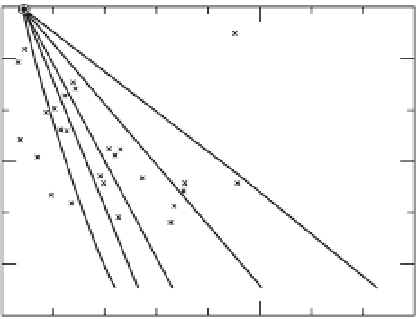Geoscience Reference
In-Depth Information
evidence for enrichment and depletion of the
various mantle reservoirs. LIL-enrichment associ-
ated with time-integrated isotopic depletion is a
simple consequence of mixing relations. Hotspot,
oceanic-island and continental flood basalts are
mixtures of a variety of components, including
recycled oceanic crust, delaminated continental
crust, 'contaminated' MORB and so on. If basalts
are mixtures, the isotopic ages of their parent
components or reservoirs will be underestimated,
the sources are more enriched or depleted in
their isotopic ratios than the hybrid magmas. The
close proximity in time and space of enriched
and depleted magmas in all tectonic environ-
ments -- continental rifts, oceanic islands, frac-
ture zones, midoceanic rifts and arcs -- and the
diversity of small-scale samples, supports the con-
cept of a heterogenous mantle. Part of the het-
erogeneity is due to plate-tectonic processes, as
discussed in earlier chapters, and part is due to
igneous petrology, the transfer around of small
degree melts. The final stage of eruption involves
commingling and homogenization of melts. Man-
tle convection and stirring probably has little
to do with the homogeneity of midocean-ridge
basalts and observed mixing arrays.
+
15
Magmas
MIXING END MEMBERS
Depleted magma
Enriched source
Partial melts from
enriched source
+
10
+
5
0.9
0
0.8
−
5
1% melt
0.5
−
10
0.2
20 10
5% melt
2
1
−
15
0
0.04
0.08
0.12
0.16
Rb
/
Sr
Fig. 25.9
Mixing relations for a depleted magma and partial
melts from an enriched peridotite reservoir. The solid lines
are mixing lines, and dashed lines give the fraction of the
depleted component.
The hypothesis that oceanic and continen-
tal magmas represent mixtures of melts from
diverse lithologies -- enriched and depleted com-
ponents -- appears capable of explaining a variety
of geochernical data and resolving some isoto-
pic paradoxes. The hypothesis explains appare-
ntly
contradictory
trace-element
and
isotopic



























